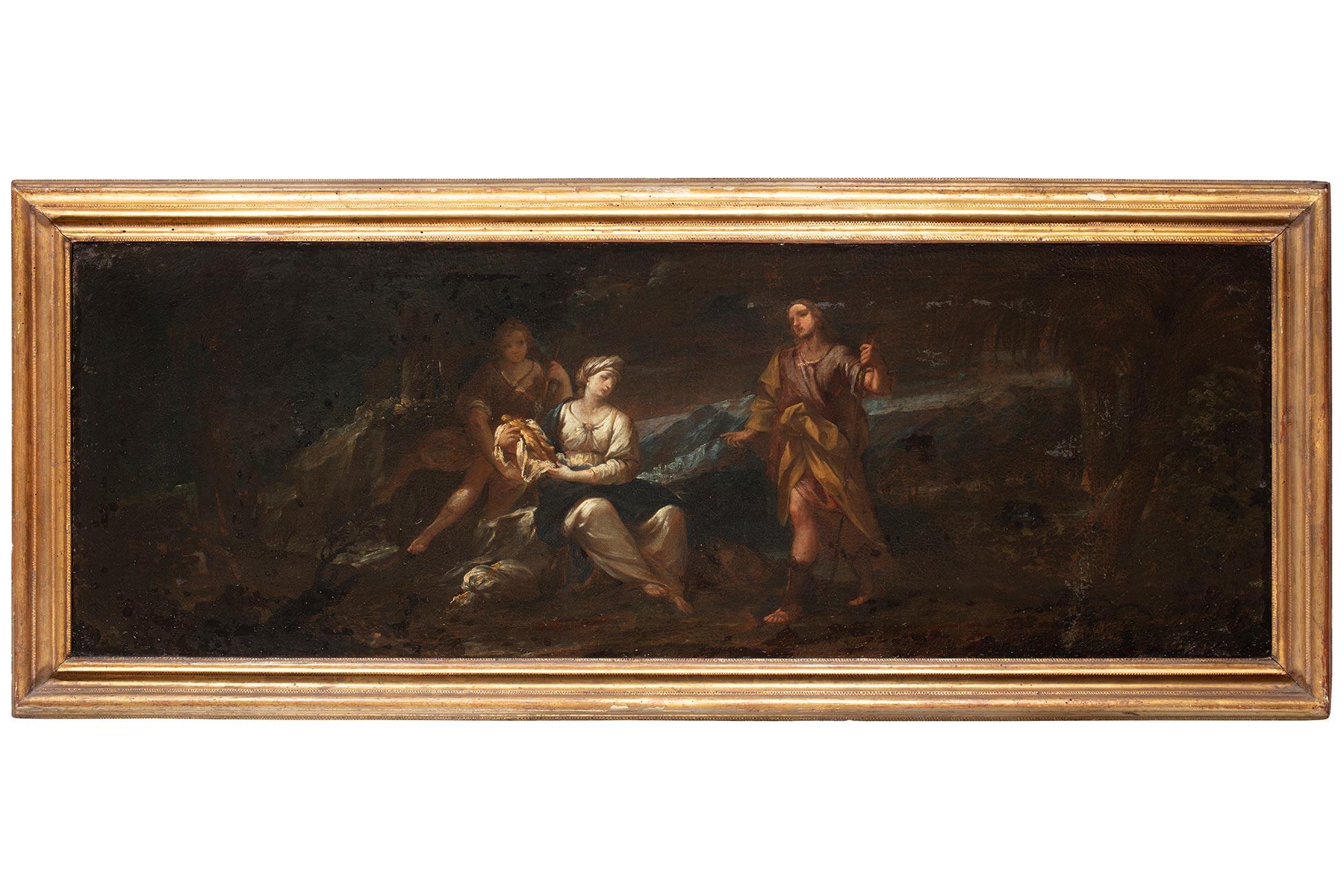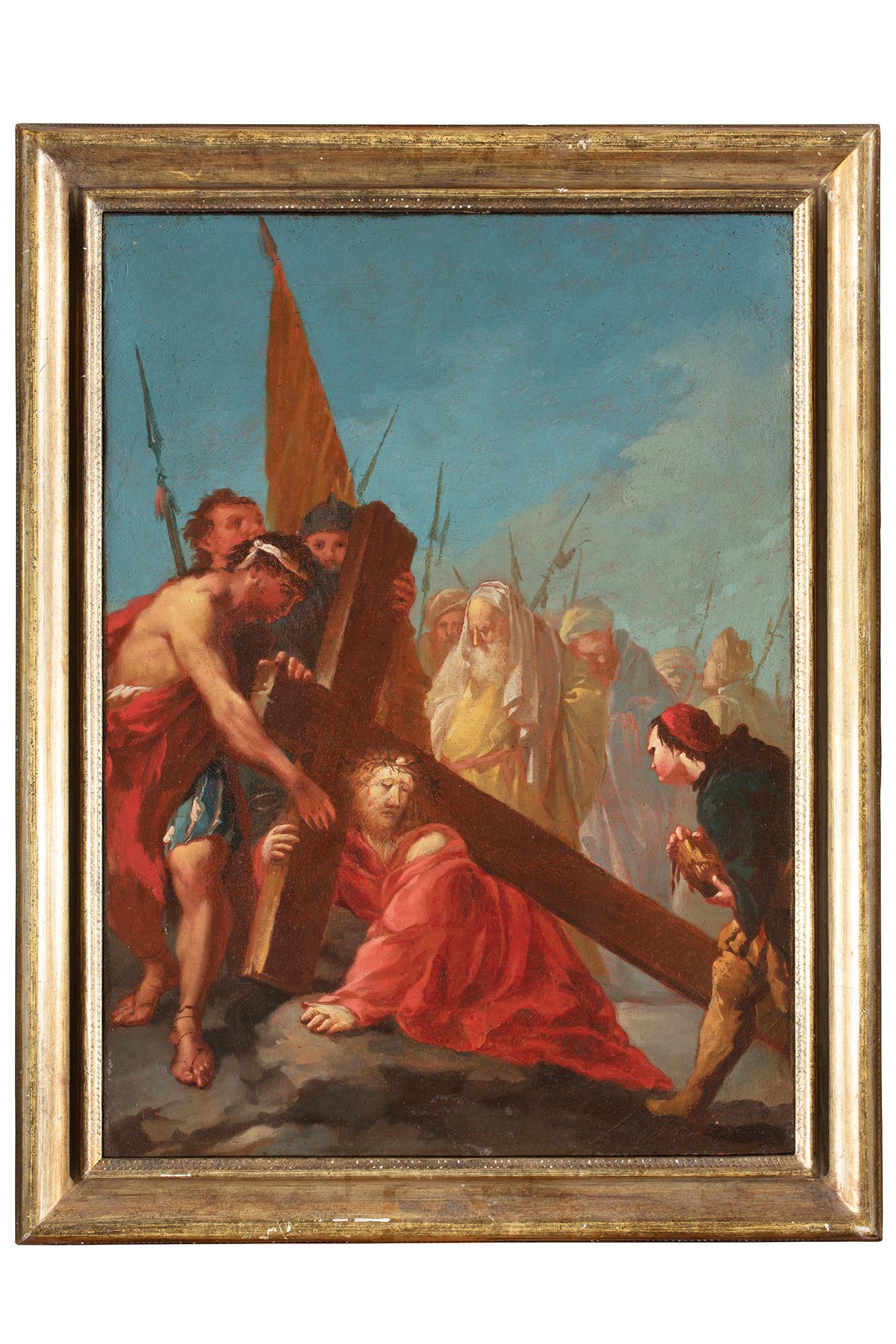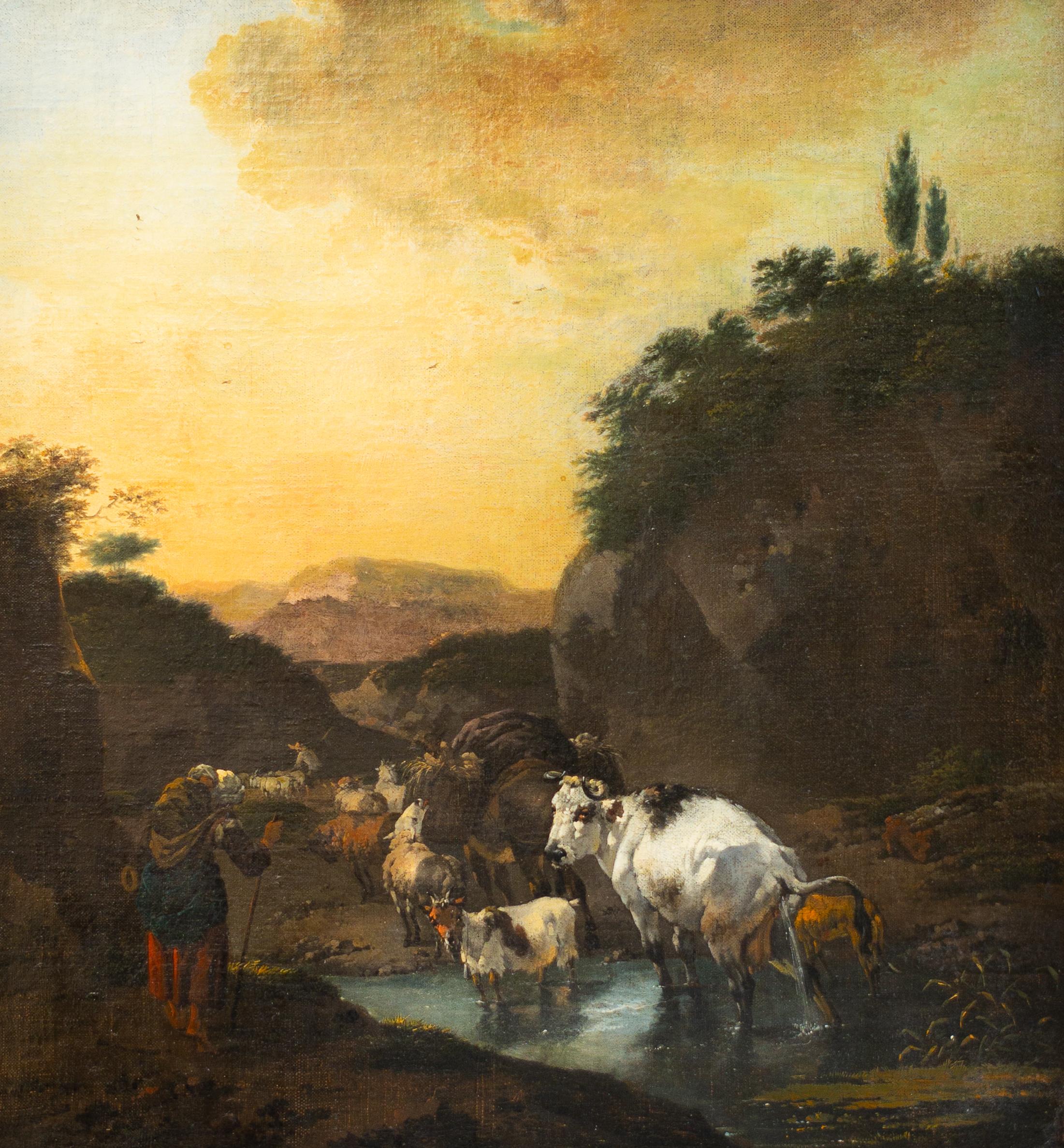Items Similar to View of St. John’s Cathedral, Antigua
Want more images or videos?
Request additional images or videos from the seller
1 of 6
Ezra BisbeeView of St. John’s Cathedral, Antigua1841
1841
About the Item
Provenance:
Robert Hollberton, Antigua, ca. 1841
Private Collection, New York
The present painting depicts Old St. John’s Cathedral on the island of Antigua. The church was erected in the 1720s on the designs of the architect Robert Cullen. It measured 130 feet by 50 feet with north and south porches 23 x 20 ½ feet. The tower, 50 feet high with its cupola, was added in 1789. The church was elevated to the status of a cathedral, but disaster struck in the form of an earthquake that destroyed the building on 8 February 1843. A memorandum of that date relates the event:
“On Wednesday, 8th February, 1843, this island was visited by a most terrific and destructive earthquake. At twenty minutes before eleven o’clock in the forenoon, while the bell was ringing for prayers, and the venerable Robert Holberton was in the vestry-room, awaiting the arrival of persons to have their marriage solemnized, before the commencement of the morning service, the whole edifice, from one end to the other, was suddenly and violently agitated. Every one within the church, after the first shock, was compelled to escape for his life. The tower was rent from the top to the bottom; the north dial of the clock precipitated to the ground with a dreadful crash; the east parapet wall of the tower thrown upon the roof of the church; almost the whole of the north-west wall by the north gallery fell out in a mass; the north-east wall was protruded beyond the perpendicular; the altar-piece, the public monument erected to the memory of lord Lavington, and the private monuments, hearing the names of Kelsick, Warner, Otley, and Atkinson, fell down piecemeal inside; a large portion of the top of the east wall fell, and the whole of the south-east wall was precipitated into the churchyard, carrying along with it two of the cast-iron windows, while the other six remained projecting from the walls in which they had been originally inserted; a large pile of heavy cut stones and masses of brick fell down at the south and at the north doors; seven of the large frontpipes of the organ were thrown out by the violence of the shock, and many of the metal and wooden pipes within displaced; the massive basin of the font was tossed from the pedestal on which it rested, and pitched upon the pavement beneath uninjured. Thus, within the space of three minutes, this church was reduced to a pile of crumbling ruins; the walls that were left standing being rent in every part, the main roof only remaining sound, being supported by the hard wood pillars.”
The entrance from the southern side into the cathedral, which was erected in 1789, included two imposing statues, one of Saint John the Divine and the other of Saint John the Baptist in flowing robes. It is said that these statues were confiscated by the British Navy from the French ship HMS Temple in Martinique waters in 1756 during the Seven Years’ War and moved to the church. The statues are still in situ and can be seen today, much as they appeared in Bisbee’s painting, but with the new cathedral in the background (Fig. 1).
Little is known of the career of Ezra Bisbee. He was born in Sag Harbor, New York in 1808 and appears to have had a career as a political cartoonist and a printmaker. His handsome Portrait of President Andrew Jackson is dated 1833, and several political lithographs concerning the Jackson presidency are of this date, including: Political Quixotism (1833) and The Vision (1834), both in the Library of Congress. Bisbee drew and produced a lithograph of the First Unitarian Congregational Church in Brooklyn (Church of the Saviour), an example of which is in the Metropolitan Museum of Art. Portraits of William Hawley of Ridgefield and his wife are dated 1843 and one of Joseph Starbuck is dated 1847.
How long Bisbee spent in Antigua is unknown, but his return to the United States was recorded in passenger and immigration lists. Ezra Bisbee, described as a “portrait painter” arrived from Antigua in New York on the British Brig Quadruple on 18 April 1842 (Fig. 2), nine months after having painted St. John’s Cathedral and barely ten months before the earthquake which would destroy it. A lithograph, likely by Bisbee himself, partially reproduces the composition of our painting, including the animals grazing in the churchyard in the right foreground (Fig. 3).
According to an inscription on the reverse of the canvas, this painting was completed by Bisbee in July 1841. It is also inscribed on the stretcher bar “St. John…Cathedral…Antigua / Bisbee” and “Robert Hollberton Archdeacon + Rector,” which indicates that the painting was previously in the possession of and likely commissioned by Robert Holberton, Rector of St. John’s Cathedral and Archdeacon of Antigua, who is mentioned in the account of the earthquake related above (Fig. 4).
- Creator:Ezra Bisbee (1808)
- Creation Year:1841
- Dimensions:Height: 30 in (76.2 cm)Width: 26 in (66.04 cm)
- Medium:
- Movement & Style:
- Period:
- Condition:
- Gallery Location:New York, NY
- Reference Number:1stDibs: LU1025778141

About the Seller
5.0
Recognized Seller
These prestigious sellers are industry leaders and represent the highest echelon for item quality and design.
Established in 1997
1stDibs seller since 2012
17 sales on 1stDibs
Typical response time: 11 hours
- ShippingRetrieving quote...Ships From: New York, NY
- Return PolicyThis item cannot be returned.
More From This SellerView All
- A WolfLocated in New York, NYProvenance: The Marchesi Strozzi, Palazzo Strozzi, Florence Sale, Christie’s, London, May 20, 1993, lot 315, as by Carl Borromaus Andreas Ruthart...Category
17th Century Old Masters Animal Paintings
MaterialsPaper, Canvas, Oil
- Allegory of AbundanceLocated in New York, NYPainted in collaboration with Hendrick van Balen (Antwerp, 1575 – 1632). Provenance: Private Collection, Uruguay, since the 1930s. The eldest son of Jan Br...Category
17th Century Old Masters Paintings
MaterialsCopper
- Ezekiel in the Valley of Dry BonesBy Philip Burne-JonesLocated in New York, NYProvenance: Christie’s, London, 3 March 1922, lot 46 (with The Tower of Babel); James Nicoll Private Collection Sotheby’s, London, 29 March 1983, lot 157 Private Collection, New Yo...Category
Late 19th Century Victorian Figurative Paintings
MaterialsOil, Canvas
- Two Scenes of Diana and Actaeon (a pair)By Giovanni Battista ViolaLocated in New York, NYProvenance: Robert L. and Bertina Suida Manning, New York, until 1996 Private Collection, USA Giovanni Battista Viola was born in Bologna a...Category
17th Century Baroque Landscape Paintings
MaterialsCopper
- Still Life with Squash, Gourds, Stoneware, and a Basket with Fruit and CheeseLocated in New York, NYProvenance: Selma Herringman, New York, ca. 1955-2013; thence by descent to: Private Collection, New York, 2013-2020 This seventeenth century Spanish still-life of a laden table, known as a bodegón, stands out for its dramatic lighting and for the detailed description of each object. The artist’s confident use of chiaroscuro enables the sliced-open squash in the left foreground to appear as if emerging out of the darkness and projecting towards the viewer. The light source emanates from the upper left, illuminating the array, and its strength is made apparent by the reflections on the pitcher, pot, and the fruit in the basket. Visible brush strokes accentuate the vegetables’ rough surfaces and delicate interiors. Although the painter of this striking work remains unknown, it is a characteristic example of the pioneering Spanish still-lifes of the baroque period, which brought inanimate objects alive on canvas. In our painting, the knife and the large yellow squash boldly protrude off the table. Balancing objects on the edge of a table was a clever way for still-life painters to emphasize the three-dimensionality of the objects depicted, as well a way to lend a sense of drama to an otherwise static image. The knife here teeters on the edge, appearing as if it might fall off the table and out of the painting at any moment. The shape and consistency of the squash at left is brilliantly conveyed through the light brush strokes that define the vegetable’s fleshy and feathery interior. The smaller gourds—gathered together in a pile—are shrouded partly in darkness and stand out for their rugged, bumpy exterior. The stoneware has a brassy glaze, and the earthy tones of the vessels are carefully modulated by their interaction with the light and shadow that falls across them. The artist has cleverly arranged the still-life in a V-shaped composition, with a triangular slice of cheese standing upright, serving as its pinnacle. Independent still-lifes only became an important pictorial genre in the first years of the seventeenth century. In Italy, and particularly through the revolutionary works of Caravaggio, painted objects became carriers of meaning, and their depiction and arrangement the province of serious artistic scrutiny. Caravaggio famously asserted that it was equally difficult to paint a still-life as it was to paint figures, and the elevation of this new art form would have profound consequences to the present day. In Spain Juan Sanchez Cotan...Category
17th Century Old Masters Still-life Paintings
MaterialsCanvas, Oil
- Job Cursed by His WifeBy Giovanni Battista LangettiLocated in New York, NYProvenance: Alfred (1883-1961) and Hermine Stiassni (1889-1962), Brno, Czech Republic, by 1925; thence London, 1938-1940; thence Los Angeles, 1940-1962; thence by descent to: Susanne Stiassni Martin and Leonard Martin, San Francisco, until 2005; thence by descent to: Private Collection, California Exhibited: Künstlerhaus, Brünn (Brno), 1925, as by Ribera. “Art of Collecting,” Flint Institute of Art, Flint, Michigan, 23 November 2018 – 6 January 2019. Literature: Alte Meister...Category
1670s Old Masters Paintings
MaterialsCanvas, Oil
You May Also Like
- View of Ponte Milvio in RomeLocated in Roma, RMNorthern painter active in Rome in the second half of the 17th century, View of Ponte Milvio Oil painting on canvas 73 x 97 cm in coeval Roman Salvator Rosa frame.Category
18th Century and Earlier Old Masters Landscape Paintings
MaterialsCanvas, Oil
- 17th Century by Simone Cantarini Adoration of The Magi Painting Oil on CanvasLocated in Milano, LombardiaSimone Cantarini (Pesaro 1612 - Verona 1648) Adoration of the Magi Oil on paper applied to canvas, cm. 16,5 x 24 – with frame cm. 22 x 29 Antique sh...Category
Early 17th Century Old Masters Figurative Paintings
MaterialsCanvas, Cotton Canvas, Oil
- 17th Century by Felice Torelli Rachel Hiding the Idols Oil on CanvasLocated in Milano, LombardiaFelice Torelli (Verona 1667 - Bologna 1748) Rachel Hiding the Idols Oil on canvas, 41 x 116 cm without frame - 52,5 x 127 cm with frame Original shape...Category
Late 17th Century Old Masters Landscape Paintings
MaterialsCanvas, Cotton Canvas, Oil
- 17th Century by Felice Torelli Hagar and the Angel Oil on CanvasLocated in Milano, LombardiaFelice Torelli (Verona 1667 - Bologna 1748) Hagar and the Angel Oil on canvas, 41 x 116 cm without frame - 52,5 x 127 cm with frame Original shaped and ...Category
Late 17th Century Old Masters Landscape Paintings
MaterialsCanvas, Cotton Canvas, Oil
- 19th Century By Giustino Menescardi Ascent to Calvary Oil on CanvasLocated in Milano, LombardiaGiustino Menescardi (Milan, c. 1720 - Venice, after 1779) Ascent of Calvary Oil on canvas, cm. 47 x 36 - with frame cm. 57x43 Shaped and gilded wooden cassetta frame Publications: Bozzetti, modelletti, sketches: dalla collezione di Giorgio Baratti...Category
Early 18th Century Old Masters Landscape Paintings
MaterialsCotton Canvas, Canvas, Oil
- Shepherd with Sheep, Cows and a Goat in a Landscape by Jan Frans SoolmakerLocated in Stockholm, SEJan Frans Soolmaker (Flanders 1635‑1685) Shepherd with Sheep, Cows and a Goat in a Landscape oil on relined canvas canvas size 56 x 53 cm frame i...Category
17th Century Old Masters Animal Paintings
MaterialsOil, Canvas
Recently Viewed
View AllMore Ways To Browse
Large Stone Basin
Antique Iron Clock
French Iron Window
Stone Altar
Large Old Bells
Antique Iron Bell
Window Frame Iron
Cast Iron Framed Art
Temple Bell
Antique Service Bells
Antique Pillar Clock
Possession Ring
Wooden French Pedestal
Brick Building Painting
Long Wall Clock
Church Clock
John Brown Clocks
Mass Church




